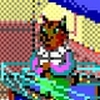Live A Live (SNES) review"It’s rare these days to see the Square-Enix name within a mile of anything original. “Rehashing sells” has been their motto for the past few years, to the detriment of the JRPG genre as a whole. However, Square wasn’t always like that (well, okay, yes they were). There was a time, back in 1994, when Square released the second-best JRPG on the SNES, second only to Earthbound. That game is Live A Live, which unfortunately never saw a release outside Japan. " |
It’s rare these days to see the Square-Enix name within a mile of anything original. “Rehashing sells” has been their motto for the past few years, to the detriment of the JRPG genre as a whole. However, Square wasn’t always like that (well, okay, yes they were). There was a time, back in 1994, when Square released the second-best JRPG on the SNES, second only to Earthbound. That game is Live A Live, which unfortunately never saw a release outside Japan.
The premise behind Live A Live is simple – Square gathered a whole bunch of popular manga artists (most of whom no one in the US has heard of, even to this day), gave them a generic JRPG engine, and told them to have at it. What resulted is a 20-or-so hour long RPG that makes Final Fantasy as a series look like the crap it is (or at least, the crap it has been since Final Fantasy 6).
Like Earthbound, Live A Live isn’t your standard JRPG. The game itself consists of nine parts, each done by a different artist, and each with its own design choices. While Live A Live isn’t exactly a Shigesato Itoi masterpiece, it definitely has its moments. The first eight chapters each focus on a single character – ranging from a caveman, to a ninja, to a cowboy, to a robot. Each character’s chapter is wildly different from all of the others, and as I mentioned before, each has their own well thought-out design decisions.
Take the Caveman’s chapter as an example. Cavemen had no spoken language, and thus the entire chapter contains next to no dialog (only a single word is spoken the entire time). The story is relayed through pictures and the character’s actions, which works surprisingly well. The Caveman theme is even bought into the battle system – all of the caveman’s move names are simple sounds (“BashBash” and “BangBang” as examples). Naturally, the caveman chapter contains a ton of combat, and has one of the hardest optional bosses in the game within. Level design in the caveman chapter is very, very simple, consisting mostly of linear caves and open areas.
In stark contrast is the ninja, Oboro. Oboro’s chapter is his mission to infiltrate a feudal Japanese castle, free a prisoner, and kill Ode Iou, the lord of the castle. The castle itself is mostly enclosed spaces, and is filled with secret passages, hidden rooms, and traps. You’re given a few different ways to complete the chapter as well. You could go through and kill every man, woman, and child in the building (which is actually much more complicated than you’d think) for a total of 100 kills. On the other hand, you can go through the castle without ever killing anyone (which again, is far more complicated than you’d think). Or you could just slaughter everything you come across in a fit of wanton destruction, disregarding your killcount entirely. Whichever way you do it, the chapter is an interesting one.
As splintered as the chapters may sound, they DO have one coherent, overarching plot. To discuss exactly what this is would completely ruin the game.
The battle system is the only thing that the first seven chapters appear to have in common. Battles take place on a small grid, using one of the only non-boring ways to do a turn-based battle system. When it’s your turn, you move your characters around the grid and set them up to attack, while at the same time trying to avoid your enemy’s attack range. This means you actually have to pay attention during battle – mashing the frameskip button will usually lead you to a swift death. There is no MP, and lost health is automatically recovered after finishing combat, meaning there’s no need to carry around 99 of every potion.
Live A Live also exhibits one of the hallmarks of a good JRPG – very little to no grinding. Unless you plan on taking out all the optional bosses and min-maxing your characters, there really isn’t a need to grind.. at least, not until the very end of the game, when some slight grinding becomes a necessity. I’m not even sure what the maximum level is, but there’s no need to hit it in order to finish the game.
LAL also has at least some replayability, unlike most JRPGs. There’s a bunch of different endings depending on which character you choose as your main in the final chapter – including one of the coolest design ideas I’ve ever seen in a JRPG. You see, one of the choices for the final chapter is the villain. Choosing the villain allows you to play as the various bosses you’ve fought in all the other chapters against the characters you spent so much time levelling up (and yes, you fight them exactly how you left them at the end of their respective chapters). Don’t ask me why, but that feels exactly like something Shigesato Itoi would do, and is one of the reasons I love this game.
It’s a damn shame that Live A Live was never released stateside. The only way you’ll ever play it in English is to download the ROM and the translation patch (which actually makes the game BETTER). LAL is definitely a game worth playing, no matter how you look at it. My final rating for this game is a 9/10, with one point subtracted because of some rather annoying terrain issues late in the game (namely having to walk through a bunch of trees with no clear path through them). Other than that, this game is golden.
 |  |  |  |  |
Community review by timrod (April 29, 2009)
A bio for this contributor is currently unavailable, but check back soon to see if that changes. If you are the author of this review, you can update your bio from the Settings page. |
|
More Reviews by timrod [+]
|
|
If you enjoyed this Live A Live review, you're encouraged to discuss it with the author and with other members of the site's community. If you don't already have an HonestGamers account, you can sign up for one in a snap. Thank you for reading!
User Help | Contact | Ethics | Sponsor Guide | Links













